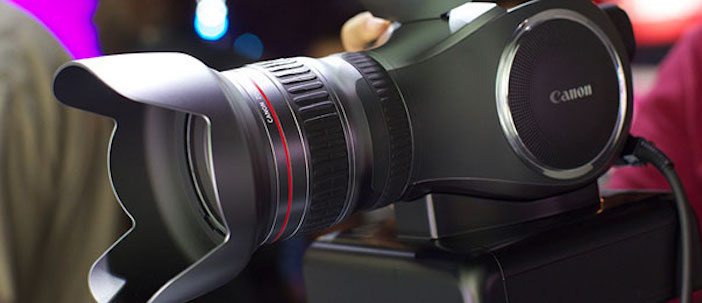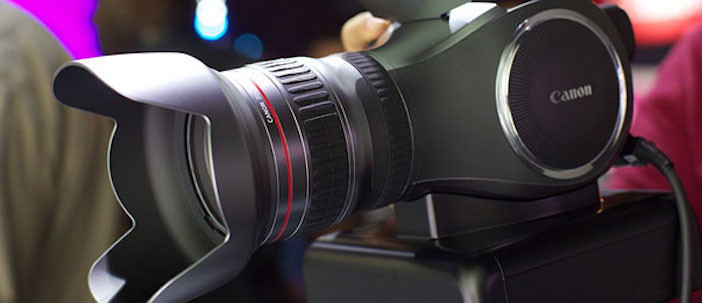The quality of 1080p had barely been made film-like before being cast aside for 4K and now manufacturers are racing to make 8K a reality, which is in the region of 36MP, before 2018.
It seems the megapixel race has truly come to filmmaking.
Questioning technology gains before they’ve happened is a risky business. With the benefit of hindsight concerns almost always turn out be unfounded.
Let me start by saying I have few concerns about 8K for cinematic capture. It’s nearly here already with RED’s full frame 8K Weapon upgrade in 2016.
And how could we possibly not like what is in the pipeline from the likes of Sony and Panasonic? 8K will offer filmmakers the chance to shoot beautiful moving 36MP full frame images and photographers the chance to use 24fps motor drive at over 40MP.
But although the technology of still and moving image capture may be converging into one and the same thing, what the hype mongers seem to have missed is that the creative techniques use to shoot each are actually diverging.
In the professional video world high end camcorders and cinema cameras have diverged from video shooting stills cameras due to the quite different demands of filmmakers. In the stills world very few photographers are plucking 8MP stills from 4K video and I don’t detect much enthusiasm for it either.
That’s not to say convergence has a lot of creative potential, it does.
It’s just that much of the hype around 8K is stupid and ill thought out, revolving around claims 36MP will suddenly change everything and photographers will be fine about giving up the shutter button, their video button permanently triggered so they don’t miss a moment.
Mindless.
Forgive me for thinking that photographic techniques and video shooting techniques are actually very different.
Photography is not just about re-timing a shot in post from a stream of 24fps 36MP stills. It is actually more about what you omit and the selectivity of what you see. It has much less to do with the sheer number of frames you capture. It’s about the creative mind’s ability to lay in wait for that decisive moment of interest and that critical subject. If you are pointing the camera in the wrong direction when one of those comes along it won’t matter if you are shooting 16K at 240fps, you will miss it.
Even for sports photography, the vast majority of time a photographer is lying in wait for the decisive moment, primed to fire off a continuous burst of stills. If they simply lay in wait with an 8K camera rolling, they will have a ton of dead time and a heap of useless data on the card which has to be sifted through in post.
A video operator is capturing a live event in realtime, being selective in a very different way about what they capture. A stills camera is aimed and timed.
In fact selectivity and timing are the main role of a photographer. If it were the case that stills capture would at some point in the future be done only through 8K video, it would leave 90% of the job of photographer up to post production instead.
All the power of selectivity would transfer from the photographer to the person in post picking individual frames. This is a massive surrender of control over the photographic process by the person behind the camera. I am not comfortable with that.
Famously neither was John Ford on the other side of the fence. The director was so selective in terms of what he filmed that he practically did the editing in-camera. This way the studio couldn’t impose their own edit over his head. The less control a client or studio has over one’s shot selection the better. I also think that shooting ‘always-on’ 8K video for stills leads to complacency. With no thought to timing you’re going to aim the camera completely differently.
For me 4K on the current mirrorless cameras is nothing more than a faster continuous burst mode when it comes to stills. It’s important not to overhype it. Hype may sell more 8K cameras to people uninterested in video but in practical reality it only allows you to fire off a longer and faster continuous burst of stills by hitting the video record button. By the way, unless you’re shooting 8K on a very high end cinema camera you stand to lose raw.
Then there’s the question of data storage and efficiency. With an 8K shoot for stills, the camera would have to be constantly capturing during the whole shoot for it to fulfil it’s raison d’être and 99% of that would be dead-time, which means many terabytes of waste. The camera would also have to be shooting 8K raw at a minimum of 24fps, preferably 60fps for finer frame re-timing in post. Considering how perhaps on some shoots as few as 10 shots might be used and 99.999% of the data completely redundant, does the cost of archiving an 8K shoot for stills make any economic sense at all?
Don’t converge technique
I will be advising all the camera manufacturers to apply their future technology in a sensible manner. We don’t just want higher numbers and ever-increasing resolution thrown around without any thought for the creative implications. We need to make really good artistic decisions about how this stuff is going to be used and hopefully influence the specs through these decisions so that the tail doesn’t wag the dog.
Where re-timing in post is beneficial I have no problem shooting 4K and 8K. They can yield some fantastic decisive moment photography in documentary situations and many more situations besides, as can high speed cameras at 240fps for instance (where a subject is just too fast for human timing).
It’s just that regardless of whether the technology (and even ergonomics) of a stills camera is eventually merged with a motion-picture camera (depending which way you look it has already happened), the different ways I go about shooting will be what delivers 99% of the results not an arbitrary or sudden convergence of the way I shoot stills and video into ‘one approach suits all’.





